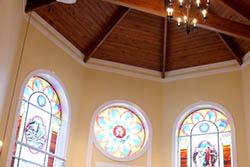“Was this the face that launched a thousand ships, and burnt the topless towers of Ilium?”
This line by Christopher Marlow in Doctor Faustus (c. 1590) is one of the most famous in Western literature. It is a reference to the beauty of Helen of Sparta who, though married to Menelaus, eloped with Paris of Troy, sparking the Trojan War, chronicled by Homer in the Iliad. I studied the Iliad as a graduate student in a class where the question was posed, “Why did the Greeks go to war with Troy?” I’ll never forget the professor’s comment: “The Greeks understood that you have to have beauty in your life.” Helen, a metaphor for all that was beautiful in Greek culture, had to be recovered, and she was worth fighting for.
Most people think that beauty is a luxury we can live without. Beautiful things don’t always have utilitarian value, so we conclude that they are unnecessary. More often than not, beautiful things are expensive. There you have it – useless and expensive. We’ll pass.
Not so fast. Human beings are hardwired to know the difference between that which is ugly and that which is beautiful. We know at the deepest level that beauty is fundamental to our nature. We naturally shun the ugly. Take a look at your home; it matters not how wealthy you are; you will insist on making it as beautiful as your means will permit. You do this because you believe that your own flourishing rests upon the well-being that beauty brings. I would suggest that God made you this way, and without this understanding of beauty you would never desire him. God is fundamentally beautiful, and enjoying Him – not merely avoiding perdition – is the highest end of man.
The New Covenant vision of a student, what we call the “portrait of the graduate,” is a student who is a lover of truth, goodness and beauty. From the earliest ages we instill a taste for beauty in a hundred tangible ways. Twenty years ago, the faculty and I imagined a campus that would be attractive, full of architectural interest, and pleasing to the eye. We painted our library a warm Chinese red and built high ceilings, when white paint and nine-foot ceilings would have sufficed. We chose natural woods, floor coverings with design, and we insisted upon natural light in hallways and classrooms. We built private courtyards to encourage leisure, and we systematically planted trees and flowers. We stained the glass in the chapel, when, of course, clear glass would have served the basic function. We cultivated real grass on our athletic fields. We discourage classroom décor that my Swiss mother-in-law would call “kitsch.” Finally, we have kept everything clean and in good repair. Moreover, outside of our buildings, every one of our beautification projects have been paid for through donated funds, and not with tuition dollars.
The students respond, sometimes in tangible ways. Have you seen the mosaic splash guards behind water fountains, or the mural in the SoR wing? All of this was the pre-condition for a particular kind of curriculum. Together with the physical environs, the classical, Christian curriculum informs the whole person. We have constructed a course of study from pre-K to senior high that includes heavy amounts of music, literature and art. Is it necessary? Um, no. Is it cheap? Definitely not. Do we need it? Only if you wish to develop a student who is a lover of truth, goodness and beauty. You can certainly choose a school where none of this is considered important.
One of the visible ways we cultivate beauty is the annual art fair which was held last Friday evening. For months our students have been working on projects in paint, pen and ink, charcoal, and in other media such as sculpture and photography. Over the months they have been exposed to great works of art and encouraged to try their own hand under the guidance of their teachers. So walk the halls where their art is displayed. You’ll find some amazing things and some that represent talent in progress. If you’re perceptive, however, you’ll see hundreds of students who are becoming young adults who love truth, goodness and beauty. That is one difference a classical, Christian education makes.





























